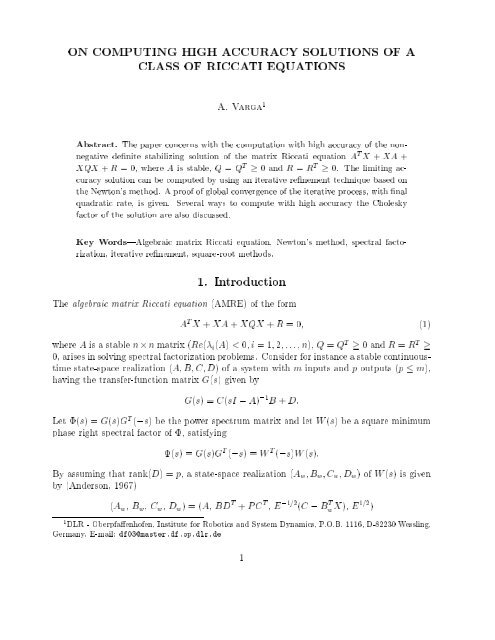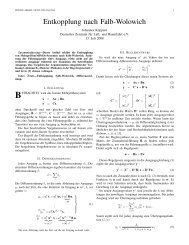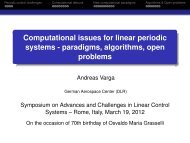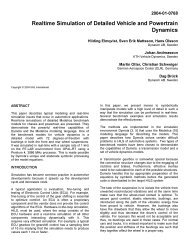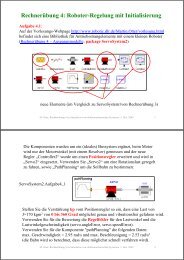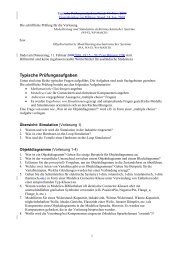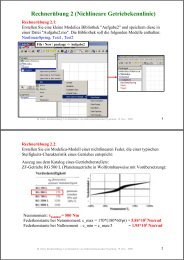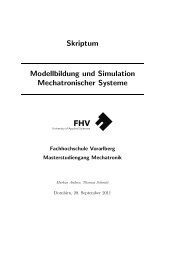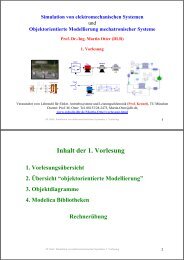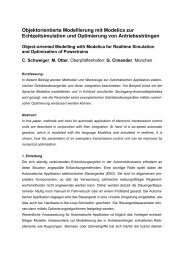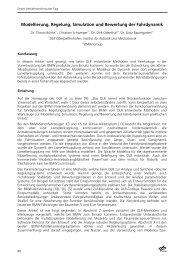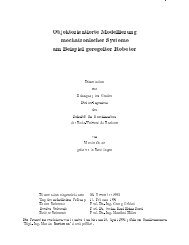On computing high accuracy solutions of a class of Riccati equations
On computing high accuracy solutions of a class of Riccati equations
On computing high accuracy solutions of a class of Riccati equations
You also want an ePaper? Increase the reach of your titles
YUMPU automatically turns print PDFs into web optimized ePapers that Google loves.
ON COMPUTING HIGH ACCURACY SOLUTIONS OF A<br />
CLASS OF RICCATI EQUATIONS<br />
A. Varga 1<br />
Abstract. The paper concerns with the computation with <strong>high</strong> <strong>accuracy</strong> <strong>of</strong> the nonnegative<br />
denite stabilizing solution <strong>of</strong> the matrix <strong>Riccati</strong> equation A T X + XA +<br />
XQX + R = 0, where A is stable, Q = Q T 0 and R = R T 0. The limiting <strong>accuracy</strong><br />
solution can be computed by using an iterative renement technique based on<br />
the Newton's method. A pro<strong>of</strong> <strong>of</strong> global convergence <strong>of</strong> the iterative process, with nal<br />
quadratic rate, is given. Several ways to compute with <strong>high</strong> <strong>accuracy</strong> the Cholesky<br />
factor <strong>of</strong> the solution are also discussed.<br />
Key Words|Algebraic matrix <strong>Riccati</strong> equation, Newton's method, spectral factorization,<br />
iterative renement, square-root methods.<br />
1. Introduction<br />
The algebraic matrix <strong>Riccati</strong> equation (AMRE) <strong>of</strong> the form<br />
A T X + XA + XQX + R =0; (1)<br />
where A is a stable n n matrix (Re( i (A) < 0;i=1; 2;:::;n), Q = Q T 0 and R = R T <br />
0, arises in solving spectral factorization problems. Consider for instance a stable continuoustime<br />
state-space realization (A; B; C; D) <strong>of</strong> a system with m inputs and p outputs (p m),<br />
having the transfer-function matrix G(s) given by<br />
G(s) =C(sI , A) ,1 B + D:<br />
Let (s) =G(s)G T (,s) bethe power spectrum matrix and let W (s) bea square minimum<br />
phase right spectral factor <strong>of</strong> , satisfying<br />
(s) =G(s)G T (,s) =W T (,s)W (s):<br />
By assuming that rank(D) =p, a state-space realization (A w ;B w ;C w ;D w ) <strong>of</strong> W (s) isgiven<br />
by (Anderson, 1967)<br />
(A w ; B w ; C w ; D w )=(A; BD T + PC T ; E ,1=2 (C , B T w X); E1=2 )<br />
1 DLR - Oberpfaenh<strong>of</strong>en, Institute for Robotics and System Dynamics, P.O.B. 1116, D-82230 Wessling,<br />
Germany. E-mail: df03@master.df.op.dlr.de<br />
1
where<br />
and P and X satisfy the <strong>equations</strong><br />
E = DD T<br />
AP + PA T + BB T =0 (2)<br />
A T X + XA +(C , Bw T X)T (DD T ) ,1 (C , Bw T X)=0: (3)<br />
P and X are respectively the controllability gramian <strong>of</strong> the system (A; B; C; D) and the<br />
observability gramian <strong>of</strong> the system (A; B w ;C w ;D w ). The last equation can be rewritten as<br />
(A , B w E ,1 C) T X + X(A , B w E ,1 C)+XB w E ,1 B T w X + CT E ,1 C =0 (4)<br />
which is in the form (1) with A ,B w E ,1 C stable. This equation belongs to a <strong>class</strong> <strong>of</strong> <strong>Riccati</strong><br />
<strong>equations</strong> specic to spectral factorization problems, with the last two terms in (4) having<br />
the same signs.<br />
The need to solve (4) with <strong>high</strong> <strong>accuracy</strong> arises in conjunction with the square-root<br />
methods for model reduction (Safonov and Chiang, 1988; Varga and Fasol, 1993), where we<br />
have to compute the Cholesky factors <strong>of</strong> the gramians P and X with comparable <strong>accuracy</strong><br />
in order to ensure the eectiveness <strong>of</strong> the square-root <strong>accuracy</strong> enhancing approach. The<br />
main diculties are encountered when the original system is not observable or is nearly<br />
unobservable because in this case the gramian X is singular or nearly singular, respectively.<br />
The diculties are caused by the fact that the rank information on X usually is recovered<br />
later, after multiplying this matrix with P or after multiplying the corresponding Cholesky<br />
factors. Therefore, in these applications it is very important that such rank decisions to be<br />
based on results computed with the <strong>high</strong>est achievable <strong>accuracy</strong>.<br />
The standard method to compute the stabilizing, non-negative denite solution X <strong>of</strong> (1)<br />
is the Schur vectors method proposed by Laub (1979). X is computed as<br />
where Z =<br />
"<br />
Z1<br />
Z 2<br />
#<br />
eigenspace <strong>of</strong> the Hamiltonian matrix<br />
X = Z 2 Z ,1<br />
1<br />
(5)<br />
is a 2n n matrix with orthonormal columns which span the stable<br />
H =<br />
"<br />
A Q<br />
#<br />
,R ,A T : (6)<br />
Although each computational step to determine X can be performed by using numerically<br />
stable procedures, the Schur method cannot be considered unconditionally numerically stable.<br />
It was pointed out by Petkov et al. (1987) that even for well conditioned problems,<br />
poor <strong>accuracy</strong> <strong>solutions</strong> can occasionally result. As pointed out by Kenney et al. (1989)<br />
an appropriate scaling <strong>of</strong> the Hamiltonian matrix improves sometimes the <strong>accuracy</strong> <strong>of</strong> the<br />
solution but, unfortunately, there exists no generally applicable straightforward scaling procedure.<br />
Therefore, we are facing frequently with computed <strong>solutions</strong> whose <strong>accuracy</strong> is lower<br />
than the <strong>high</strong>est attainable <strong>accuracy</strong> permitted by the conditioning <strong>of</strong> the problem. In order<br />
to attain this limiting <strong>accuracy</strong> solution, an iterative renement technique, similar to that<br />
2
suggested by Arnold and Laub (1984) and Kenney et al. (1990), is usually necessary to be<br />
performed.<br />
In this paper we investigate the use <strong>of</strong> Newton's method for solving equation (1) and for<br />
iterative renement <strong>of</strong> approximate <strong>solutions</strong>. The main result is the theorem presented in<br />
the next section, which states the global convergence <strong>of</strong> this method with a nal quadratic<br />
convergence rate. The result is similar with those obtained by Kleinman (1968) and (Sandell,<br />
1974) for the standard <strong>Riccati</strong> equation where the constant and quadratic terms have<br />
dierent signs. In section 3 we discuss several possibilities to compute the Cholesky factor<br />
<strong>of</strong> the limiting <strong>accuracy</strong> solution. An example illustrating the eectiveness <strong>of</strong> the proposed<br />
approach is given in section 4. Some conclusions are presented in section 5.<br />
2. Newton's iterative method<br />
We assume that the AMRE (1) has a unique positive semi-denite stabilizing solution, that<br />
is, there exists X 0 such that A + QX is stable. The existence <strong>of</strong> such a solution <strong>of</strong><br />
(1), provided A is stable, is that the Hamiltonian matrix H in (6) has no eigenvalues on<br />
the imaginary axis (Kano and Nishimura, 1993). In what follows, we assume this condition<br />
fullled.<br />
The problem addressed in this section is how to solve iteratively the equation (1), provided<br />
an approximation X j,1 <strong>of</strong> X is available. Consider the Lyapunov equation<br />
(A + QX j,1) T X j + X j (A + QX j,1)+R , X j,1QX j,1 =0 (7)<br />
which produces the next iterate X j when applying the Newton's method to iteratively solve<br />
(1). The following theorem is the main result <strong>of</strong> the paper.<br />
Theorem 1. Let X 0 = X T 0<br />
be a stabilizing approximation <strong>of</strong> X = X T 0, the unique<br />
stabilizing solution <strong>of</strong> the AMRE (1). Let X j be the symmetric solution <strong>of</strong> the Lyapunov<br />
equation (7) for j =1; 2;:::;. Then:<br />
(a) X 1 X 2 ::: X j X j+1 ::: X<br />
(b) lim j!1 X j = X<br />
(c) There exists > 0 such that k X , X j kk X , X j,1k 2 .<br />
In (c) and in what follows kkstays for any consistent matrix norm. In order to prove the<br />
theorem, we prove rst the following two lemmas.<br />
Lemma 1. If X j,1 is a stabilizing approximation <strong>of</strong> X, then the solution X j <strong>of</strong> (7) satises<br />
X j X and A + QXj is stable.<br />
Pro<strong>of</strong>. By subtracting (7) from (1), where we replaced X by X, we obtain<br />
(A+QX j,1) T ( X ,Xj )+( X ,Xj )(A+QX j,1)+X j,1QX j,1+ XQ X ,Xj,1Q X , XQXj,1 =0<br />
or<br />
(A + QX j,1) T ( X , Xj )+( X , Xj )(A + QX j,1)+( X , Xj,1)Q( X , Xj,1) =0<br />
3
By applying Lyapunov's theorem (Barnett, 1971), we have X Xj .<br />
By rewriting dierently the above expression, we obtain<br />
(A+QX j ) T ( X ,Xj )+( X ,Xj )(A+QX j )+(X j ,X j,1)Q(X j ,X j,1)+( X ,Xj )Q( X ,Xj )=0<br />
By applying again Lyapunov's theorem (Barnett, 1971), the stability <strong>of</strong> A + QX j follows<br />
because X , Xj 0. 2<br />
Lemma 2. If X j and X j+1 are successive approximations computed from a stabilizing approximation<br />
X j,1 <strong>of</strong> X, then Xj and X j+1 satisfy X j X j+1 X. <br />
Pro<strong>of</strong>. From Lemma 1, it follows that X j X and Xj+1 X and thus we have to show<br />
that X j X j+1 . Let E(Y )bethe residual for Y <strong>of</strong> the AMRE (1), dened by<br />
The residual for X j , the solution <strong>of</strong> equation (7), is<br />
E(X j ) = A T X j + X j A + X j QX j + R<br />
E(Y )=:A T Y + YA+ YQY + R: (8)<br />
= (A + QX j,1) T X j + X j (A + QX j,1)+R , X j,1QX j,1 ,<br />
X j,1QX j , X j QX j,1 + X j QX j + X j,1QX j,1 =(X j , X j,1)Q(X j , X j,1) 0:<br />
From the equation satised by X j+1 ,we have<br />
(A + QX j ) T (X j+1 , X j )+(X j+1 , X j )(A + QX j )+E(X j )=0:<br />
By applying Lyapunov's theorem, we obtain X j X j+1 . 2<br />
Pro<strong>of</strong> <strong>of</strong> Theorem 1. The pro<strong>of</strong> <strong>of</strong> the theorem parallels a similar pro<strong>of</strong> for standard<br />
<strong>Riccati</strong> equation done by Mehrmann (1991). Lemma 1 shows that for a given stabilizing<br />
approximation X 0 <strong>of</strong> X, the sequence X1 ;X 2 ;:::; is well dened, that is,<br />
X j X; j =1; 2;:::;<br />
and the matrices A + QX j ; j =1; 2;:::; are stable. By Lemma 2, the sequence X 1 ;X 2 ;:::;<br />
is nondecreasing and bounded above by X 0, the stabilizing solution <strong>of</strong> (1). Therefore,<br />
by the Bolzano-Weierstra theorem, this sequence is convergent to the unique stabilizing<br />
solution X. Thus, points (a) and (b) <strong>of</strong> the theorem are proven.<br />
In order to prove (c), we subtract (7) from (1) in which we replaced X by X, to obtain<br />
(A+Q X) T ( X ,Xj )+( X ,Xj )(A+Q X)+(Xj ,X j,1)Q(X j ,X j,1),( X ,Xj )Q( X ,Xj )=0<br />
This implies<br />
0 X , Xj R 1<br />
0<br />
e t(A+Q X) T [(X j , X j,1)Q(X j , X j,1)]e t(A+Q X) dt<br />
kX j , X j,1k 2R 1<br />
0<br />
e t(A+Q X) T Qe t(A+Q X) dt =: kX j , X j,1k 2 Y<br />
where Y 0 satises<br />
(A + Q X) T Y + Y (A + Q X)+Q =0:<br />
4
Thus, we obtain<br />
k X , Xj kkY kkX j , X j,1k 2 = kX j , X j,1k 2 k X , Xj,1k 2<br />
since X j , X j,1 X , X j,1. 2<br />
Remarks. (i) A straightforward choice for initializing the sequence X j , j = 1; 2;::: is<br />
X 0 = 0, the matrix A being stable. With this initialization, X 1 0 and Lemma 1 insures<br />
a monotonic convergence to the solution X. By (c), the convergence has nally a quadratic<br />
rate.<br />
(ii) If X 0 is an arbitrary stabilizing approximation <strong>of</strong> X (computed for instance with the<br />
Schur vectors method), we have a guaranteed monotonic convergence only after the rst<br />
iteration. This aspect was already observed by Kenney et al. (1990) for the case <strong>of</strong> standard<br />
<strong>Riccati</strong> equation. Thus, generally we cannot assume that X 1 0, and in fact X 1 can be<br />
even a negative denite matrix. A similar example as that given in (Kenney et al., 1990)<br />
can be easily constructed for the considered <strong>Riccati</strong> equation (1). The stabilizing solution<br />
for the AMRE (A = ,I; Q = I; R =0:75I)<br />
,2X + X 2 +0:75I =0<br />
is X =0:5I. With >0 and X0 =(1, )I, the matrix A + QX 0 = ,I and thus is stable.<br />
The rst approximation X 1 is<br />
X 1 = (1 , , )2 , 0:75<br />
I<br />
2<br />
which for small is clearly a large negative denite matrix. Therefore, if a poor approximation<br />
X 0 is to be expected (for example the <strong>Riccati</strong> equation is ill-conditioned), then it is<br />
advisable, in order to speed-up the convergence, to reinitialize the iteration after the rst<br />
step with X0<br />
~ = max(0;X 1 ).<br />
(iii) Usually no more than 9-11 iterations <strong>of</strong> the Newton's method are necessary to compute<br />
the limiting <strong>accuracy</strong> solution <strong>of</strong> (1) when we choose X 0 = 0. Thus, the solution <strong>of</strong><br />
the AMRE (1) requires usually no more than 120n 3 ops (oating point operations), where<br />
we assumed 10 iterations and 12n 3 ops were considered to solve the Lyapunov equation.<br />
When X 0 is an approximate solution computed by the Schur vectors method, then at most<br />
3-4 iterations are additionally necessary to achieve the <strong>high</strong>est attainable <strong>accuracy</strong>. The<br />
whole procedure to compute X requires about 120n3 ops instead <strong>of</strong> about 75n 3 ops required<br />
by using only the Schur method. This increase with about 50% <strong>of</strong> the computational<br />
eort is sometimes necessary in order to attain the necessary <strong>accuracy</strong> <strong>of</strong> the solution. Notice<br />
that the scaling <strong>of</strong> the Hamiltonian matrix (6), as suggested in (Kenney et al., 1989),<br />
for enhancing the numerical <strong>accuracy</strong> <strong>of</strong> the Schur method requires the solution two times<br />
<strong>of</strong> the <strong>Riccati</strong> equation and is always more expensive and less accurate than the iterative<br />
renement technique.<br />
3. Computation <strong>of</strong> the Cholesky factor<br />
In several applications, as for instance in the square-root balanced stochastic truncation<br />
method (Varga and Fasol, 1993), we need instead X its Cholesky factor S. Even if a<br />
5
suciently accurate X is available, the direct computation <strong>of</strong> the Cholesky factorization X =<br />
S T S is generally not recommendable from numerical point <strong>of</strong> view because the computed<br />
factor has usually lower <strong>accuracy</strong> than the given X. In the worst case, we can expect a loss <strong>of</strong><br />
<strong>accuracy</strong> equivalent to half <strong>of</strong> signicant digits <strong>of</strong> the solution. When X is nearly or exactly<br />
singular, the rank information can be even lost due to roundo errors when <strong>computing</strong> the<br />
Cholesky factor. For instance, if X has a singular value <strong>of</strong> order , then S will have a singular<br />
value <strong>of</strong> order 1=2 , which could be a non-negligible quantity even when is negligible. What<br />
makes the problem even more dicult in the mentioned model reduction application, is that,<br />
this rank information must be recovered later, after performing some operations with the<br />
computed factor. The purpose <strong>of</strong> this section is to discuss several other possible methods to<br />
compute S.<br />
Method 1. We discuss rst the computation <strong>of</strong> the Cholesky factor S by using the Schur<br />
method (Laub, 1979). Accuracy losses arise here due to the instability <strong>of</strong> the inversion step<br />
when <strong>computing</strong> X = Z2 Z ,1<br />
1 . Provided the <strong>Riccati</strong> equation is well scaled, that is k Xk1 <br />
(Kenney et al., 1989), we can avoid the explicit inversion <strong>of</strong> Z 1 by using the following<br />
approach suggested by Singer and Hammarling (1983). We compute rst the singular value<br />
decomposition<br />
Z 1 = UV T ;<br />
where U and V are orthogonal matrices and = diag( 1 ;:::; n ). Because Z 1 is a part <strong>of</strong><br />
a matrix with orthogonal columns and is invertible, we have<br />
1 1 ::: n > 0:<br />
The solution X can be expressed as<br />
X = U( ,2 , I) 1=2 U T<br />
and thus the Cholesky factor can be computed as<br />
S =( ,2 , I) 1=4 U T :<br />
q Notice that the computation <strong>of</strong> V is not necessary in order to determine S. It is easy to see<br />
that k Xk2<br />
= ,2<br />
n , 1 and thus we have an immediate indication on the expected <strong>accuracy</strong><br />
<strong>of</strong> the computed solution. Even the information on the rank <strong>of</strong> X can be computed from<br />
the computed singular values. The rank deciency <strong>of</strong> X (and thus <strong>of</strong> S too) is given by the<br />
number <strong>of</strong> singular values which are equal to 1. In order to not lose this information because<br />
<strong>of</strong> roundo errors, we can set the respective singular values exactly to 1 before <strong>computing</strong> S.<br />
However, when using this approach, always we have to take into account the possibility to<br />
lose half <strong>of</strong> <strong>accuracy</strong> due to the square root operations in evaluating S. 2<br />
Method 2. Let Q = V T V and R = U T U be the Cholesky factorizations <strong>of</strong> the positive<br />
semidenite matrices Q and R. Although generally not unique, such factorizations always<br />
exist with V and U upper triangular and with non-negative diagonal elements. A square-root<br />
version <strong>of</strong> the Newton's method can be derived by rewriting (7) as<br />
(A + QX j,1) T (X j , X j,1)+(X j , X j,1)(A + QX j,1)+E(X j,1) =0 (9)<br />
6
and taking into account that for j 2, the term E(X j,1) can be expressed as<br />
E(X j,1) =(X j,1 , X j,2)Q(X j,1 , X j,2):<br />
By Theorem 1, X j , X j,1 0 for j 2, and thus, there exists the Cholesky factorization<br />
X j , X j,1 = H T j H j:<br />
The Cholesky factor S j <strong>of</strong> X j can be recursively computed from the equality<br />
S T j S j = S T j,1 S j,1 + H T j H j<br />
by using a stable algorithm for updating the Cholesky factorization (Gill et al., 1974). The<br />
following procedure represents a square-root version <strong>of</strong> the Newton's method to solve the<br />
AMRE (1):<br />
1) Set S 0 = 0 and compute H 0 by solving<br />
2) For j =1; 2;::: (until convergence)<br />
2.1) Compute H j by solving<br />
A T (H T 0 H)+(HT 0 H)A + U T U =0<br />
(A+QS T j,1 S j,1) T (H T j H j)+(H T j H j)(A+QS T j,1 S j,1)+(VH T j,1 H j,1) T (VH T j,1 H j,1) =0<br />
2.2) Compute S j from<br />
S T j S j = S T j,1 S j,1 + H T j H j:<br />
This algorithm is primarily intended as an alternative more accurate approach for the iterative<br />
solution <strong>of</strong> the AMRE (1). It is slightly more expensive than the original version <strong>of</strong><br />
the Newton's method discussed in the previous section. Both methods are particularly well<br />
suited when, due to ill-conditioning <strong>of</strong> the AMRE (1), the initial approximation (computed<br />
for instance with the Schur method) is not stabilizing or the Schur method fails (for<br />
instance the Hamiltonian (6) loses the dichotomy property due to roundo). An additional<br />
advantage <strong>of</strong> the square-root approach is that it provides directly the Cholesky factor <strong>of</strong> the<br />
stabilizing solution. Note that the proposed square-root method to solve the AMRE (1) is<br />
<strong>of</strong> incremental type and thus <strong>of</strong> dierent nature than the square-root iteration proposed by<br />
Hammarling (1982a) for solving the standard <strong>Riccati</strong> equation.<br />
The use <strong>of</strong> this algorithm for iterative renement raises some problems. Generally we<br />
cannot assume that an arbitrary positive semidenite stabilizing approximation X 0 satises<br />
X 0 X and thus it is suitable to initialize the square-root iteration. Therefore we have<br />
to compute rst X,1 X and X0 X by performing two standard Newton's iterations<br />
(7) initialized with X 0 . By Lemma 1, X,1 X 0 and we can compute the Cholesky factors<br />
H 0 and S 0 <strong>of</strong> X 0 , X,1 and <strong>of</strong> X 0 , respectively. These computations can lead however to<br />
<strong>accuracy</strong> losses especially if X is (nearly) singular, an aspect already mentioned before. 2<br />
Method 3. Generally we cannot assume that R , X j,1QX j,1 0 in (7) and thus<br />
this equation is not suitable for directly <strong>computing</strong> the Cholesky factor S j . The following<br />
7
approach exploiting the linearity <strong>of</strong> (7) can be used to determine S j if X j > 0: compute rst,<br />
by using the method <strong>of</strong> (Hammarling, 1982b), S j1 and S j2 , the <strong>solutions</strong> <strong>of</strong> the <strong>equations</strong><br />
(A + QX j,1) T (S T j1 S j1)+(S T j1 S j1)(A + QX j,1)+U T U =0 (10)<br />
(A + QX j,1) T (S T j2 S j2)+(S T j2 S j2)(A + QX j,1)+(VX j,1) T (VX j,1) =0 (11)<br />
and then, determine S j such that<br />
X j =: S T j S j = S T j1 S j1 , S T j2 S j2: (12)<br />
S j can be reliably determined from S j1 and S j2 , without forming the products S T S j1 j1 and<br />
S T S j2 j2, by using an algorithm for downdating the Cholesky factorization. We performed<br />
experiments with the downdating algorithm <strong>of</strong> Bojanczyk and Steinhardt (1991), but because<br />
in our case generally X j 0, we encountered diculties in approaching the limiting <strong>accuracy</strong><br />
solution in those cases when X was singular. These diculties can be explained with the<br />
ill-conditioning <strong>of</strong> the downdating problem for the positive semi-denite case. However,<br />
<strong>equations</strong> (10)-(12), excluding the computation <strong>of</strong> S j , represent an alternative way (although<br />
more expensive) to perform the Newton's iterative renement. This approach led sometimes<br />
to more accurate <strong>solutions</strong> than those computed with the iteration based on (7). 2<br />
Method 4. If an accurate solution X is already available, a straightforward way to<br />
compute reliably its Cholesky factor S is by solving directly for S either the equation<br />
or<br />
A T (S T S)+(S T S)A +"<br />
V X<br />
U<br />
# T "<br />
V X<br />
U<br />
(A + 1 2 Q X) T (S T S)+(S T S)(A + 1 2 Q X)+U T U =0: (13)<br />
These <strong>equations</strong> are obtained by dierently grouping the terms in the AMRE (1). The<br />
stability <strong>of</strong> A + 1 Q <br />
2 X is guaranteed by Lyapunovs Theorem.<br />
Numerical experiments indicate that equation (13) should be generally preferred. It can<br />
be viewed as a step <strong>of</strong> the following iteration for i =1; 2; :::<br />
#<br />
=0<br />
(A + 1 2 QX j,1) T X j + X j (A + 1 2 QX j,1)+R =0 (14)<br />
Experimentally it was observed that the iterations based on (14) converge to the stabilizing<br />
solution X provided the initializing approximation X0 is not too far from X. In most cases<br />
the convergence rate was however very low and thus equation (14) is not appropriate for<br />
iterative renement. However its contracting property (a conjecture based on experiments)<br />
is in our case very useful, allowing to safely perform a "last step" after the convergence <strong>of</strong><br />
Newton's method in order to compute the Cholesky factor <strong>of</strong> the solution. 2<br />
Summarizing the above considerations, the following two main alternatives are possible<br />
to compute accurate Cholesky factors <strong>of</strong> the solution <strong>of</strong> the <strong>Riccati</strong> equation (1). If an<br />
accurate solution X has been already determined by using for instance the Schur method<br />
with or without iterative renement, then Method 4. based on equation (13) should be<br />
generally preferred because <strong>of</strong> its already mentioned <strong>accuracy</strong> rening property. Appropriate<br />
8
quantities to assess the <strong>accuracy</strong> <strong>of</strong> the computed solution are the corresponding residual,<br />
the norm <strong>of</strong> X and/or the condition number <strong>of</strong> the <strong>Riccati</strong> equation. The second alternative<br />
is to use Method 2. to solve the <strong>Riccati</strong> equation and is particularly well suited if the <strong>Riccati</strong><br />
equation is <strong>high</strong>ly ill-conditioned. Notice that in many cases the iterative solution by using<br />
Method 2. is computationally less expensive than by using the Schur method with or even<br />
without iterative renement.<br />
4. Numerical example<br />
The example given in this section is intended to illustrate the eectiveness <strong>of</strong> the proposed<br />
iterative renement technique in <strong>computing</strong> the limiting <strong>accuracy</strong> solution <strong>of</strong> the AMRE<br />
(4) arising in the balanced stochastic truncation model reduction method (Varga and Fasol,<br />
1993). The computations have been performed on an IBM AT computer, in double precision,<br />
using the following 10-th order non-minimal (uncontrollable and unobservable) system<br />
"<br />
A B<br />
C D<br />
#<br />
=<br />
2<br />
64<br />
,6 ,1 0 0 0 0 0 0 0 0 1 0 0 0<br />
1 ,8 0 0 0 0 0 0 0 0 0 0 0 0<br />
0 0 ,10 3 0 0 0 0 0 0 0 1 0 0<br />
0 0 1 ,8 0 0 0 0 0 0 0 0 0 0<br />
0 0 0 0 ,13 ,3 9 0 0 0 1 0 0 0<br />
0 0 0 0 1 ,8 0 0 0 0 0 0 0 0<br />
0 0 0 0 0 1 ,8 0 0 0 0 0 0 0<br />
0 0 0 0 0 0 0 ,14 ,9 0 0 1 0 0<br />
0 0 0 0 0 0 0 1 ,8 0 0 0 0 0<br />
0 0 0 0 0 0 0 0 0 ,2 10 ,3 10 ,3 0 0<br />
0 1 0 1 0 0 0 0 0 510 5 0 0 0<br />
0 0 0 0 0 0 ,6 1 ,2 510 5 0 0 0 <br />
The parameter appearing in the expression <strong>of</strong> D is used to modify the conditioning <strong>of</strong><br />
the <strong>Riccati</strong> equation (4) in order to illustrate the eects <strong>of</strong> the iterative renement. In the<br />
Table 1 we included, for values <strong>of</strong> ranging from 10 ,4 to 10 2 , the following results: kE(0)k 1 ,<br />
kE( X)k1<br />
~ and kE( X)k1<br />
, the norms <strong>of</strong> residuals <strong>of</strong> the AMRE (4) for X = 0, X = X ~ (the<br />
solution computed with the Schur vectors method) and X = X (the <strong>high</strong> <strong>accuracy</strong> solution<br />
computed by using iterative renement), respectively; N(0) and N( X), ~ the numbers <strong>of</strong><br />
iterations necessary for the convergence <strong>of</strong> the Newton's method initialized with X 0 = 0 and<br />
X 0 = X, ~ respectively; and cond( X), an estimation <strong>of</strong> the condition number <strong>of</strong> the <strong>Riccati</strong><br />
equation (Kenney and Hewer, 1990). The values <strong>of</strong> are given decreasingly, the smaller is<br />
the more ill-conditioned is the AMRE. For all values <strong>of</strong> , k Xk1<br />
10 6 , thus the scaling<br />
<strong>of</strong> the AMRE (4) has practically the same eect on the <strong>accuracy</strong> <strong>of</strong> the Schur method for<br />
dierent values <strong>of</strong> .<br />
3<br />
75<br />
9
Table 1<br />
10 2 10 1 10 ,1 10 ,2 10 ,3 10 ,4<br />
kE(0)k 1 5.010 7 5.010 9 5.010 11 5.010 13 5.010 15 5.010 17 5.010 19<br />
kE( X)k1<br />
~ 3.210 ,8 4.510 ,7 4.110 ,5 3.210 ,1 7.510 2 4.010 4 5.110 6<br />
kE( X)k 1 3.210 ,8 4.510 ,7 3.810 ,5 9.710 ,3 5.010 ,1 3.110 1 7.010 3<br />
N(0) 6 9 12 16 20 25 28<br />
N( X) ~ 0 0 1 1 2 3 4<br />
cond( X) 2.710<br />
5<br />
2.010 7 2.010 9 2.010 11 3.310 13 3.710 15 3.710 17<br />
It is apparent from this table that the eectiveness <strong>of</strong> the iterative renement increases<br />
as the problem becomes more ill-conditioned. With the help <strong>of</strong> iterative renement, in all<br />
cases it was possible to determine correctly the order (six) <strong>of</strong> the minimal realization <strong>of</strong> the<br />
system (A; B; C; D) from the product WS T , where W and S are the Cholesky factors <strong>of</strong> P<br />
and X, respectively. Note that this was not possible for the last two values <strong>of</strong> by only<br />
using the solution computed with the Schur method.<br />
5. Conclusions<br />
A technique for <strong>computing</strong> <strong>high</strong> <strong>accuracy</strong> <strong>solutions</strong> <strong>of</strong> a <strong>class</strong> <strong>of</strong> <strong>Riccati</strong> <strong>equations</strong> arising<br />
in spectral factorization problems has been proposed. The proposed iterative renement<br />
is based on Newton's method. A pro<strong>of</strong> <strong>of</strong> convergence with nal quadratic rate is given.<br />
Square-root versions <strong>of</strong> the basic algorithm, iterating directly on Cholesky factors, have<br />
been discussed. The main applications <strong>of</strong> these techniques are in insuring the eectiveness<br />
<strong>of</strong> the square-root <strong>accuracy</strong> enhancing approaches in certain model reduction methods.<br />
Acknowledgment. The author's work was partly carried out with the assistance <strong>of</strong> the<br />
Alexander von Humboldt Foundation, Bonn, F.R.G.<br />
References<br />
Anderson, B. D. O. (1967). A system theory criterion for positive real matrices. SIAM J.<br />
Control, 5, 171{182.<br />
Arnold III, W. F. and A. J. Laub (1984). Generalized eigenproblem algorithms and s<strong>of</strong>tware<br />
for algebraic <strong>Riccati</strong> <strong>equations</strong>. Proc. <strong>of</strong> IEEE, 72, 1746{1754.<br />
Barnett, S. (1971). Matrices in Control Theory. Van Nostrand Reinhold Co., London.<br />
Bojanczyk, A. W. and A. O. Steinhardt (1991). Stability analysis <strong>of</strong> a Householder-based<br />
algorithm for downdating the Cholesky factorization. SIAM J. Sci. Stat. Comput.<br />
12, 1255{1265.<br />
Gill, P. E., G. H. Golub, W. Murray and M. A. Saunders (1974). Methods for modifying<br />
matrix factorizations. Math. Comput. 28, 505{535.<br />
10
Hammarling, S. J. (1982a). Newton's method for solving the algebraic <strong>Riccati</strong> equation. NPL<br />
Report DITC 12/82. National Physical Laboratory, Teddington, Middlesex, UK.<br />
Hammarling, S. J. (1982b). Numerical solution <strong>of</strong> the stable, non-negative denite Lyapunov<br />
equation. IMA J. Numer. Anal. 2, 303{323.<br />
Kano, H. and T. Nishimura (1993). Nonnegative-denite <strong>solutions</strong> <strong>of</strong> algebraic matrix <strong>equations</strong><br />
with nonnegative-denite quadratic and constant terms. Research Report TDU-<br />
IS-39. Dept. Inf. Scie., Tokyo Denki University.<br />
Kenney, C., A. J. Laub and M. Wette (1989). A stability enhancing scaling procedure for<br />
Schur-<strong>Riccati</strong> solvers. Systems Control Lett. 12, 241{250.<br />
Kenney, C., A. J. Laub and M. Wette (1990). Error bounds for Newton renement <strong>of</strong> <strong>solutions</strong><br />
to algebraic <strong>Riccati</strong> <strong>equations</strong>. Math. Control, Signals, Systems, 3, 211{224.<br />
Kenney, C. and G. Hewer (1990). The sensitivity <strong>of</strong> the algebraic and dierential <strong>Riccati</strong><br />
<strong>equations</strong>. SIAM J. Numer. Anal. 28, 50{69.<br />
Kleinman, D. L. (1968). <strong>On</strong> an iterative technique for <strong>Riccati</strong> equation computations. IEEE<br />
Trans. Autom. Control, AC-13, 114{115.<br />
Laub, A. (1979). A Schur method for solving the algebraic <strong>Riccati</strong> equation. IEEE Trans.<br />
Autom. Control, AC-24, 913{921.<br />
Mehrmann, V. L. (1991). The Autonomous Linear Quadratic Control Problem. Vol. 163 <strong>of</strong><br />
Lect. Notes Contr. Inf. Science. Springer Verlag. Berlin.<br />
Petkov, P. H., N. D. Christov and M. M. Konstantinov (1987). <strong>On</strong> numerical properties<br />
<strong>of</strong> the Schur approach for solving the matrix <strong>Riccati</strong> equation. Systems Control Lett.<br />
9, 197{201.<br />
Safonov, M. G. and R. Y. Chiang (1988). Model reduction for robust control: aSchur relative<br />
error method. Int. J. Adapt. Contr. & Sign. Proc. 2, 259{272.<br />
Sandell, N. R. (1974). <strong>On</strong> Newton's method for <strong>Riccati</strong> equation solution. IEEE Trans.<br />
Autom. Control, AC-19, 254{255.<br />
Singer, M. A. and S. J. Hammarling (1983). The algebraic <strong>Riccati</strong> equation: a summary review<br />
<strong>of</strong> some available results. NPL Report DITC 23/83. National Physical Laboratory,<br />
Teddington, Middlesex, UK.<br />
Varga, A. and K. H. Fasol (1993). A new square-root balancing-free stochastic truncation<br />
model reduction algorithm. In: Prepr. <strong>of</strong> 12th IFAC World Congress, Sydney, Australia.<br />
Vol. 7. pp. 153{156.<br />
11


